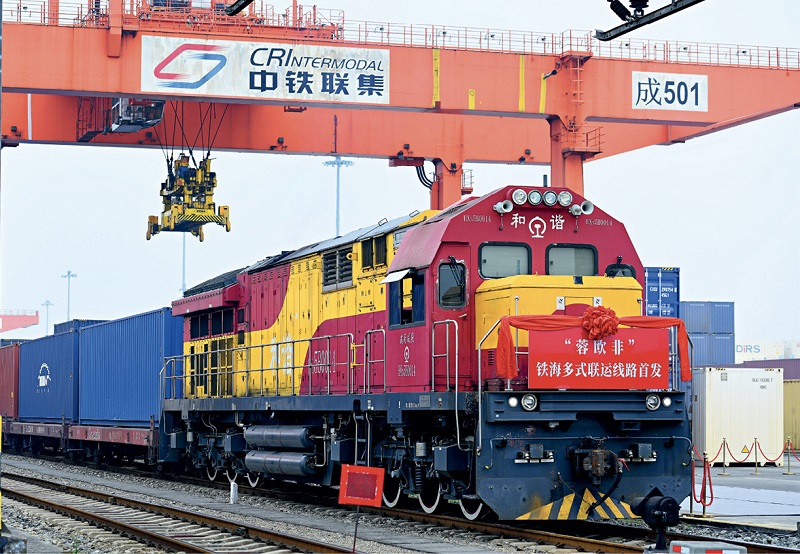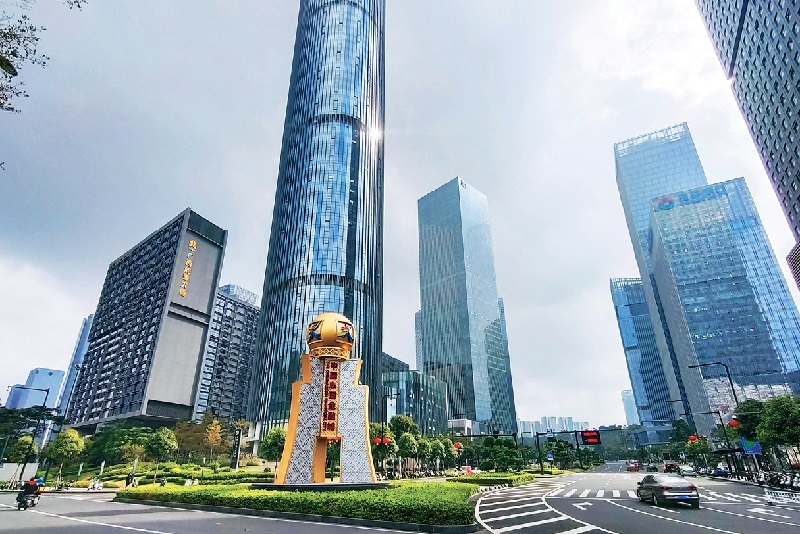Unwaveringly implementing the innovation-driven development strategy can provide a strong momentum for China’s sustained economic development.
Southwest China’s Chengdu City announced the launching of the first-ever Chengdu-Europe-Africa rail-sea multimodal transport line on October 15, 2022, one day before the opening of the 20th National Congress of the Communist Party of China (CPC). The fully-loaded freight train will first arrive in Hamburg, Germany via the China-Europe Railway Express. Then it will travel by sea to its final destination Casablanca, Morocco. The whole journey is estimated to last around 35 days.
According to the report to the 20th National Congress of the CPC, by promoting high-standard opening-up, China will steadily expand institutional opening-up with regard to rules, regulations, management, and standards to accelerate its transformation into a trader of quality goods. The country will promote high-quality development along the Belt and Road routes and endeavor to preserve the diversity and stability of the international economic landscape and economic and trade relations.
“The opening of the line is an excellent case in point,” said Zhang Yansheng, chief researcher of the China Center for International Economic Exchanges. He believes that since the 18th National Congress of the CPC in 2012, China has been adhering to the basic national policy of opening-up to the outside world and firmly pursuing mutual benefits and win-win results. The country has been continuing to provide new opportunities for the world with its new development, promoting the construction of an open world economy, and is bringing benefits to the people of various countries.
The report lays out a new blueprint for China’s economic development over the next five years and beyond. “China adheres to the correct direction of economic globalization, and is working with other countries to create an international environment conducive to development, and provide new momentum for global development,” said Bai Ming, deputy director of the International Market Research Institute under the Chinese Academy of International Trade and Economic Cooperation.

A freight train, carrying mostly local products like textiles, leaving Chengdu on October 15, 2022 marks the opening of the Chengdu-Europe-Africa rail-sea multimodal transport line.
Innovation-Driven Development
Since the 18th National Congress of the CPC in 2012, China has made a major strategic choice to place innovation as the primary driving force of its development, accelerated the construction of an innovation-oriented country, and embarked on a path of independent innovation with Chinese characteristics. Through innovation-driven development, it will boost economic growth in terms of both quality and quantity.
“The implementation of the innovation-driven development strategy is of strategic significance in helping China form new advantages in international competition and enhance the long-term development momentum,” said Wu Qiang, a professor at the Business School of Beijing Technology and Business University. Since the implementation of China’s reform and opening-up in 1978, the low-cost advantages of labor, resources, and environment have served as the major driving force behind the country’s rapid economic development. As it is entering a new stage of development, China’s low-cost advantages have gradually faded away. “Compared with low-cost advantages, technological innovation has outstanding features such as being difficult to imitate and high added value, and innovation promises a long duration and strong competitiveness,” said Wu. A steady implementation of the innovation-driven development strategy in the process of accelerating the transformation from low-cost advantages to innovation advantages can provide a strong momentum for China’s sustained economic development.
Innovation undoubtedly plays an essential role in promoting China’s new development paradigm. According to the report, China regards science and technology as the primary productive force, talents as the primary resource, and innovation as the primary driver of growth. “If these three ‘primaries’ are in place, there will be a more solid guarantee for high-quality development,” said Bai Ming. “Innovation depends on talents, and we need to respect knowledge and talents more.” The implementation of the innovation-driven development strategy is a practical way to help the country improve the quality and efficiency of economic growth and accelerate the transformation of the economic development mode.
Wu Qiang believes that scientific and technological innovation has a multiplier effect. It can not only be directly transformed into productive forces, but also amplify the productivity of various production factors by improving the overall productivity level of society with new technology. Besides, implementing the strategy will have long lasting effects in helping reduce resource and energy consumption, improving the ecological environment, and building a beautiful China. “Implementing the strategy, accelerating technological innovation, and using high-tech and advanced applicable technologies to transform and upgrade traditional industries will not only replace the development model with excessive resource consumption and environment pollution, but also enhance industrial competitiveness,” said Wu.
Speaking of innovation-driven development, economic expert Zhang Lianqi believes that the growth of the digital economy is unprecedentedly fast, widespread, and influential, and is becoming a vital force in reorganizing global resources, reshaping the global economic structure, and changing the global competition pattern. “The digital economy has become a new engine for China’s high-quality development,” he said, adding that promoting the deep integration of the digital and the real economy and building a modern economic system with international competitiveness is a pivot for transforming and upgrading traditional industries.

Participants in the "Chinese Bridge" competition, a worldwide Chinese language contest, visit the Palace Museum in Beijing on October 19, 2019.
High-level Opening-up
China must accelerate efforts to foster a new pattern of development that focuses on the domestic economy and features a positive interplay between domestic and international economic flows. China is striving to create new opportunities for the world with its own development and to contribute its share to building an open global economy that delivers greater benefits to all peoples. The report lays out the direction and goal of promoting high-level opening-up in many aspects.
According to Zhang Yansheng, China is unswervingly pursuing a mutually beneficial and win-win opening strategy, which not only draws development impetus from the world, but also enables its development to better benefit the world. In a retrogressive global economy, global industrial chains and supply chains are shrinking, and the international trade and investment has decelerated. China, however, will unswervingly expand its opening-up, continue to push the opening-up of commodity and factor flow, keep on institutional opening-up such as rules and regulations and knowledge-based opening-up to a new level.
In Bai Ming’s opinion, as China’s economic strength leaps into a new stage, the development pattern of dual circulation also needs to be upgraded, and the implementation of high-level opening-up is an inevitable requirement to improve the quality and level of international circulation.
Wu Qiang believes that to promote high-level opening-up, outbound investment must also be expanded, to benefit the people of various countries. “In the fierce international competition in investment and trade, it is necessary to jointly create an international environment that is conducive to development and oppose deglobalization behavior, such as extreme unilateralism and protectionism,” he said, believing that it is crucial to maintain international trade relations based on WTO rules.
“As a blueprint for China’s development during the next five years or even longer, the report refers to the word ‘opening’ many times, allowing the world to see a China that adheres to openness and opposes isolation, adheres to mutual benefit and win-win results rather than playing ‘zero-sum game,’” said Zhang Lianqi. The deep economic integration between China and the world is not only conducive to China’s economic development, but also injects new impetus into the sluggish world economy and stabilizes the overall situation of economic globalization, he noted.

High-rise buildings in China-ASEAN Financial Town in Wuxiang New District in Nanning, Guangxi Zhuang Autonomous Region.
Stabilizing World Economy
According to the report, the unprecedented changes the world is facing are posing great challenges, the likes of which human society has never seen before. The world is now in a historical crossroads, and its future course will be decided by all the peoples in this world. For its part, China has always been committed to its foreign policy of upholding world peace and promoting common development, and is dedicated to promoting a human community with a shared future.
“China promotes common global development. Maintaining a diversified and stable economic pattern and good economic and trade relations has become the guiding principle of future development,” said Wu Qiang. As the world’s second largest economy, China has already become an important engine of the world economy, and its economic performance plays a key role in the world economy. Over the past decade, China’s economy has grown at an average annual rate of 6.6 percent, ranking at the forefront of the world’s major economies. Besides, China’s average contribution rate to world economic growth exceeds 30 percent, more than the combined contribution rate of the G7 countries.
In Wu’s opinion, “The Belt and Road Initiative is the best example of maintaining a diversified and stable economic pattern, which has been recognized and participated in by many countries.” According to the report, the Belt and Road Initiative has been welcomed by the international community both as a public good and a cooperation platform. China has become a major trading partner for more than 140 countries and regions; it is leading the world in total volume of trade in goods and has become a major destination for global investment as well as a leading country in outbound investment.
“China resolutely upholds multilateral economic and trade cooperation and opposes any form of unilateralism, trade protectionism and bullying,” said Yu Miaojie, a famous economist and president of Liaoning University. In terms of opening-up, Yu holds that, in addition to developing and implementing the Belt and Road projects, China should actively promote a new pattern of comprehensive opening-up and push for multilateral cooperation including regional cooperation. “The report’s mentioning of sticking to the path of economic globalization means that China has always been the main force in promoting globalization and demonstrates its sincerity in opening up to the outside world,” Yu said.
A series of China’s plans for global well-being were reaffirmed in the report showing how China is committed to promoting a new type of international relations, deepening and expanding global partnerships based on equality, openness, and cooperation, and adhering to the right course of economic globalization. It is committed to working with other countries to foster an international environment conducive to development and create new drives for global growth. China is playing an active part in the reform and development of the global governance system, upholds true multilateralism, and is doing its part to make global governance fairer and more equitable. “China has always adhered to the concept of peace, development, cooperation, and win-win results, stabilizing a turbulent and changing world,” said Zhang Yansheng.